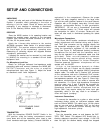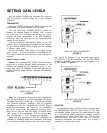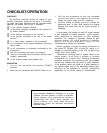
THE WIRELESS MICROPHONE
. . . what it is, what it does . . .
The wireless microphone is actually a system consist-
ing of a microphone, a transmitter, and a receiver. The
microphone is an electroacoustic transducer-a device
which converts sound waves (voice, musical in-
struments, etc.) to electrical impulses, which are sent to
the transmitter. The transmitter generates a radio-
frequency carrier, modulates this carrier with the
microphone signals, and radiates this modulated RF
signal like a tiny radio station. The receiver is matched
to the transmitter frequency and picks up the transmitter
signal through its antenna. The receiver’s circuitry
detects the modulated RF signal and converts it to an
audio voltage for routing (through a microphone input) to
an audio mixer.
At this point, the wireless system acts like any
microphone input to a sound system. The figure below
shows the complete system, including that which is not
a part of the wireless microphone system.
Frequency Bands.....
Shure wireless transmitters and receivers are single-
channel, crystal-controlled units operating at selected
frequencies in the VHF-FM band between 150 and 186
megahertz. A total of 10 frequencies, computer-selected
for interference-free operation, are readily available, and
other frequencies can be ordered on a special basis.
This means that up to seven systems can be operated in
a single sound installation, simultaneously and without
intermodulation problems.*
*If more than seven systems are contemplated, Shure recommends the use of
DIVERSIPHASE™ wireless microphone receivers.
Multipath.....
The most troublesome aspect of wireless microphone
operation can be a phenomenon known as multipath
transmission, or simply, multipath. This appears as a
signal “dropout,”
with annoying static or complete
(although temporary) signal loss. It’s caused when the
direct signal and a reflected signal-bounced off walls,
ceiling, metallic objects, etc.-arrive at the receiver at
different times, literally out-of-phase, or when the signal
path is completely unobstructed.
You’ve probably experienced this phenomenon with
the FM radio in your car. A dropout location, most likely
caused by buildings, mountains, or even telephone
poles, causes your radio signal to drop to a low, noisy
level -sometimes disappearing completely. This is
multipath.
How can multipath be minimized? The following
general rules will help achieve optimum wireless
microphone operation:
l Maintain line-of-sight transmission (the transmitter
wearer should always be able to see the receiver
antenna)
l Keep the distance between transmitter and receiver
antenna as short as possible
l Avoid RF signal blocking by furniture, scenery, etc.
l Make sure both transmitter and receiver antennas
are vertically positioned.
l Don’t operate the transmitter with a weak or un-
suitable battery
Multiple Miking.....
More than one wireless microphone system can be
used in one sound installation, but each must operate at
a different frequency. Shure’s complement of 10 stan-
dard transmitter-receiver frequencies is generally suffi-
cient for any installation, but additional, special-order
frequencies can also be supplied for a nominal service
charge.
Directional Sensitivity.....
The transmitter radiates omnidirectionally, that is, ap-
proximately equally in all directions. However, the signal
is attenuated by bodies, walls, and other surrounding ob-
jects. The receiving antenna is similarly sensitive to
radiation from all directions.
Audio Performance.....
Three important characteristics of high-fidelity audio
performance are wide frequency response, low distor-
tion and good signal-to-noise ratio. The Shure wireless
system uses high-quality FM circuitry for wide-range fre-
quency response. Distortion is kept to a minimum
TYPICAL WIRELESS MICROPHONE SYSTEM
3


















